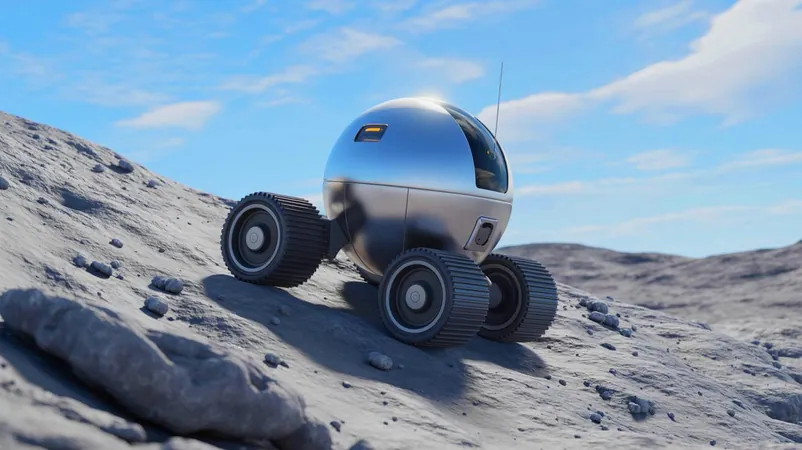
**Meet the Future of Robotics: Texas A&M's Giant Rolling Robots Inspired by a Classic 1960s Sci-Fi Show!**
2025-09-04
Author: Ming
Texas Scientists Unveil Revolutionary Spherical Robots
At Texas A&M University, a groundbreaking project is reshaping the way robots navigate challenging environments. Led by engineer Robert Ambrose, these innovative, spherical robots come alive with the ability to roll effortlessly over obstacles, taking inspiration from the eerie globe-shaped robot featured in the infamous 1960s series, "The Prisoner." Could these creations redefine exploration not just on Earth, but also on the Moon?
A Blast from the Past: The Concept's Unusual Inspiration
The idea of a rolling robot might sound pulled straight from the pages of a sci-fi novel, and indeed, it captures the essence of 'The Prisoner.' This show introduced viewers to a menacing, spherical robot that didn't just roll—it engulfed everything in its path, leaving a lasting impression on those who dared to watch. It's this captivating design that has ignited the imaginations of engineers at Texas A&M.
From NASA to Texas A&M: The Beginning of RoboBall
Initially conceived at NASA in 2003, the RoboBall project found new energy when Ambrose joined the Robotics and Automation Design Lab. The focus? To explore how these robots could tackle the treacherous landscapes of the Moon, leveraging their spherical shape to access regions traditional rovers might find too daunting.
Innovative Engineering: Meet the RoboBall Prototypes
Texas A&M has rolled out two versions of its dynamic design: RoboBall II and RoboBall III. The smaller RoboBall II is a two-foot marvel, featuring a soft outer shell and a unique internal propulsion system that boasts a pendulum to help it roll in any direction. This robot can glide across a variety of surfaces—think grass, gravel, and even water—reaching speeds of up to 20 mph. The more advanced RoboBall III, a robust six-foot variant, is tailored for performance, capable of transporting sensors, cameras, and even tools for sampling. It's designed to inflate and deflate, adjusting its traction for various terrains, making it a versatile companion for lunar exploration.
Field Testing: The Next Step for RoboBall
As the project advances, the team is set to conduct extensive field tests on the picturesque beaches of Galveston, Texas. These trials aim to assess how well RoboBall adapts to shifting between water and land, which could be pivotal for future missions. Moreover, innovative applications for these robots are being explored right here on Earth, particularly in emergency situations.
A Vision for the Future: Disaster Response with RoboBall
Imagine a fleet of these spherical robots rolling into action after a hurricane, mapping flooded areas, locating survivors, and delivering crucial information—all without endangering human lives. Graduate student Rishi Jangale envisions just that, providing hope for their use in search and rescue operations.
Facing Challenges and Looking Ahead
While the RoboBall project is brimming with potential, challenges lie ahead. Engineers are diligently working to overcome the technical obstacles associated with the spherical design and ensure it can operate in the harsh climate of space. Additionally, optimizing payload integration is a key focus to enhance these robots' reliability. The ongoing research at Texas A&M could lead to remarkable breakthroughs in robotic exploration. As these spherical robots evolve, there's no telling what new frontiers they might help us discover!
In essence, the emergence of these innovative spherical robots is a significant milestone in robotics. By challenging conventional designs, Texas A&M is forging a path toward revolutionary exploration methods, poised to transform both lunar expeditions and disaster response efforts on Earth. As we look to the stars, how will these game-changing robots reshape our understanding of the cosmos?

 Brasil (PT)
Brasil (PT)
 Canada (EN)
Canada (EN)
 Chile (ES)
Chile (ES)
 Česko (CS)
Česko (CS)
 대한민국 (KO)
대한민국 (KO)
 España (ES)
España (ES)
 France (FR)
France (FR)
 Hong Kong (EN)
Hong Kong (EN)
 Italia (IT)
Italia (IT)
 日本 (JA)
日本 (JA)
 Magyarország (HU)
Magyarország (HU)
 Norge (NO)
Norge (NO)
 Polska (PL)
Polska (PL)
 Schweiz (DE)
Schweiz (DE)
 Singapore (EN)
Singapore (EN)
 Sverige (SV)
Sverige (SV)
 Suomi (FI)
Suomi (FI)
 Türkiye (TR)
Türkiye (TR)
 الإمارات العربية المتحدة (AR)
الإمارات العربية المتحدة (AR)